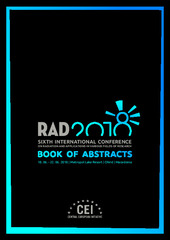Приказ основних података о документу
Extremely high beryllium-7 surface concentrations in Europe: a case study
| dc.creator | Ajtić, Jelena | |
| dc.creator | Brattich, Erika | |
| dc.creator | Hernández-Ceballos, Miguel Angel | |
| dc.creator | Sarvan, Darko | |
| dc.creator | Djurdjević, Vladimir | |
| dc.date.accessioned | 2022-01-11T09:17:38Z | |
| dc.date.available | 2022-01-11T09:17:38Z | |
| dc.date.issued | 2018 | |
| dc.identifier.isbn | 978-86-80300-03-0 | |
| dc.identifier.uri | https://vet-erinar.vet.bg.ac.rs/handle/123456789/2347 | |
| dc.description.abstract | Beryllium-7 is a cosmogenic radionuclide that, due to its maximum production in the stratosphere and upper troposphere, has often been used as a tracer of vertical transport processes in the atmosphere. In particular, high concentrations of surface airborne beryllium-7 could be a result of an uncommonly fast descent of air masses from the stratosphere into the troposphere. Hence, our aim is to investigate the maxima in the beryllium-7 surface concentrations to better understand the processes associated with the downward transport from the stratosphere to the troposphere. Fourteen locations in Europe, with latitudes ranging between 37 °N and 69 °N, and longitudes between 6 °W and 28 °E, are analysed in our study. Over the 2001–2010 period, the beryllium-7 surface concentration measurements in the chosen sites were performed mostly once a week, giving a total of about 500 data points per each site. The data are contained within the online Radioactivity Environmental Monitoring (REM) Database. We define the beryllium-7 maxima as values exceeding the 95th percentile calculated for each site. Over 2001–2010, 345 maxima are identified for the investigated 14 sites, out of which 61 maxima (18 %) occurred during three consecutive months: May, June and July 2006. Over this period, i.e. summer 2006, the contribution of detected maxima to the total number of maxima for each site ranged between 4 % and 32 %, with six sites showing a contribution of 20 % or larger. This number of extremely high beryllium-7 specific activities concentrated over only three months marks this period as unique. In an attempt to identify underlying mechanisms that are associated with this exceptional episode of high beryllium-7 surface concentrations, we look into the potential vorticity, surface temperature and pressure, and precipitation maps over the region of interest during the time window when the extremes were observed. | |
| dc.publisher | Niš : RAD Association | |
| dc.rights | openAccess | en |
| dc.rights.uri | https://creativecommons.org/licenses/by/4.0/ | |
| dc.source | 6th International Conference on Radiation and Applications in Various Fields of Research (RAD), Book of Abstracts, Jun 18-22, 2018, Ohrid, Macedonia | en |
| dc.subject | beryllium-7 | |
| dc.subject | Be-7 | |
| dc.subject | Europe | |
| dc.title | Extremely high beryllium-7 surface concentrations in Europe: a case study | en |
| dc.type | conferenceObject | en |
| dc.rights.license | BY | |
| dc.citation.spage | 169 | |
| dc.citation.epage | 169 | |
| dc.citation.rank | M34 | |
| dc.identifier.fulltext | http://veterinar.vet.bg.ac.rs/bitstream/id/6490/bitstream_6490.pdf | |
| dc.identifier.rcub | https://hdl.handle.net/21.15107/rcub_veterinar_2347 | |
| dc.type.version | publishedVersion | |
| dc.identifier.cobiss | 266468620 |

